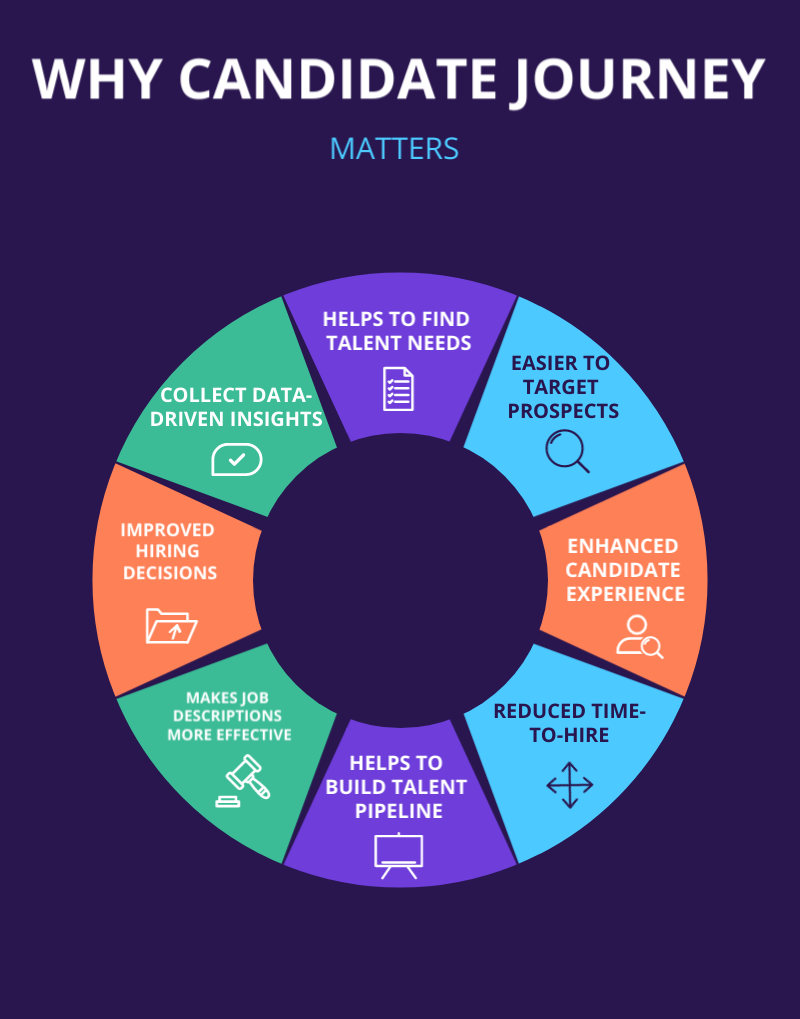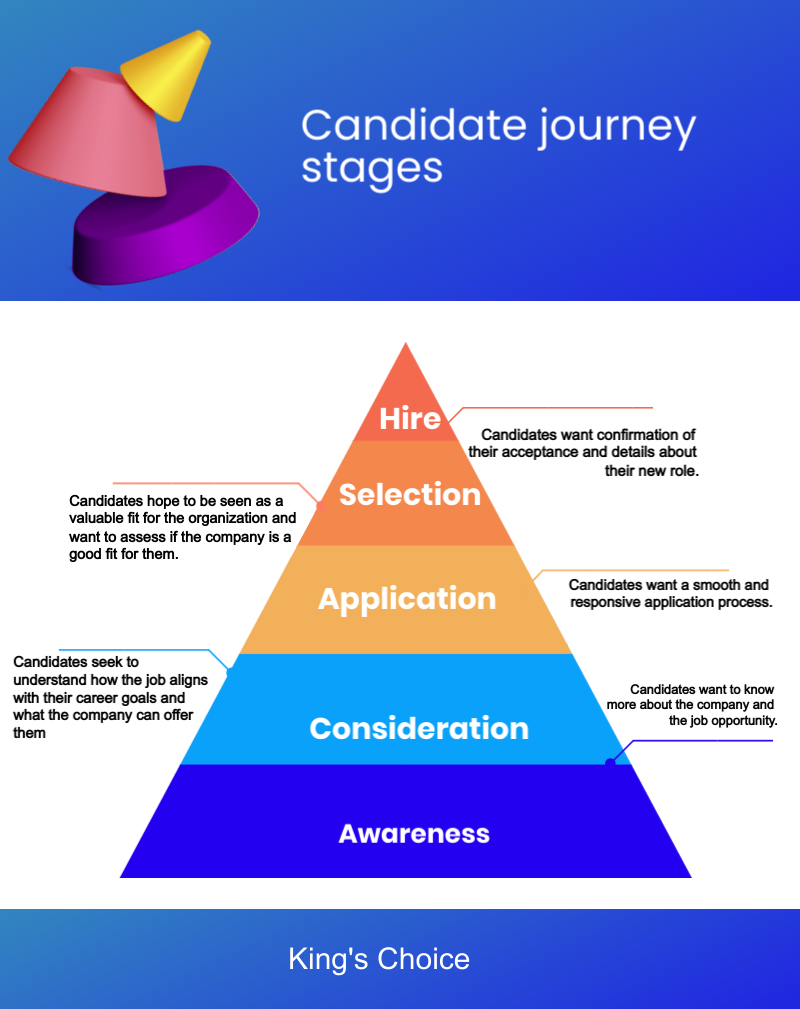Anatomy of a Successful Hiring Process

Intro
The candidate journey is the process a job seeker goes through when interacting with your company, from initial awareness of a job opportunity to becoming an employee.
With the candidate journey in place, recruiters get to optimize their processes, create a positive candidate experience, attract and retain top talent effectively.
The more you align your recruitment strategy with the candidate journey, the easier it gets to find the talent that matches your exact needs. Steps, practices that work, candidate journey explained — all in this article.
Reason to Work On Candidate’s Journey

Why care about the candidate’s journey at all? Even though it may seem like an unnecessary headache, you can change your opinion after finding out how exactly it benefits your recruitment process.
Finding Talent Needs
Identifying gaps in the talent pool becomes easier — after mapping a candidate journey, recruiters understand which roles are frequently vacant or experience high turnover. With this knowledge, they can proactively plan their hiring needs and develop strategies to attract and retain talent in critical areas.
Effective Job Descriptions
Creating job descriptions that really hit the mark is much easier when you understand a candidate journey. It lets companies showcase the key responsibilities, what you gotta bring to the table, and how candidates can grow in the role — nearly everything you need to get a candidate’s attention at this stage.
Targeted Recruitment Marketing
With the high risks of losing the budget of an ineffective marketing, a candidate journey map is your reassurance that your efforts will not go to waste. Whether it’s through social media, job boards, or industry-specific platforms, knowing the candidate journey helps in choosing the right channels to reach potential candidates.
Enhanced Candidate Experience
When your recruiting team understands the candidate journey, they can streamline their application process, provide timely feedback, and offer a seamless interview experience, which adds to the positive candidate’s experience. This improves the likelihood of candidates accepting job offers and potentially becoming brand advocates, even if they are not hired.
Reduced Time-to-Hire
By knowing the candidate journey, you can find bottlenecks and streamline their recruitment process. This reduces the time it takes to fill a position, which is crucial for securing top talent before competitors do.
Building a Talent Pipeline
Knowledge of the candidate journey lets companies build and maintain a talent pipeline. Even if a candidate is not immediately hired, they may be a good fit for future roles.
Stages of the candidate journey, explained
The candidate journey consists of several stages that a potential candidate goes through when applying for a position and interacting with a potential employer.
Awareness
This is where it all kicks off — the first stage where a candidate gets wind of a job opening and gets to know your company. They might hear about it from job ads, social media, your website, from a friend or colleague. If you’ve worked on building a referral system previously, the initial stage may be the only one you need to go through to close the vacancy.
Consideration
After getting to know what your company offers,candidates enter the consideration stage. Here, they want to know more about the role and the company culture, diving into what you have to offer. They might research the company’s website, read employee reviews, and compare the position with other opportunities.
Employer branding, clear job descriptions, and a compelling company culture play a significant role in influencing candidates during this stage.
Application
This is the point at which candidates decide to apply for the job, submitting their resumes and completing any required application forms or assessments. The easier you make this process, the more candidates you retain at this stage.
Screening and selection
Once candidates apply, you keep communication with them before the interview. It may involve CV reviews, skills assessments, or pre-employment tests — all of it falls under this stage of the candidate journey.
Interviews
Phone, video, and in-person interviews can all be a part of this stage. That’s when the most important assessment happens: you evaluate a candidate’s skills, qualifications, cultural fit, and overall suitability for the role.
Offer and negotiation
What’s important to include in the offer is details about compensation, benefits, and other terms of employment. Candidates may negotiate the offer before accepting it.
Onboarding
During the onboarding phase, candidates complete paperwork, receive training, and become familiar with the company’s culture, policies, and procedures. A smooth onboarding process is crucial for a positive candidate experience and employee retention.
Integration and early employment
While new specialists adapt to their new role, team, and responsibilities, support from the company, effective communication, and a welcoming environment are the key to employee well-being.
Long-term engagement & alumni network
The candidate journey doesn’t end with hiring. It continues into the employee’s long-term engagement with the organization and alumni network. Providing opportunities for growth, development, feedback, and recognition are important to retain top talent and ensure their continued satisfaction. Even when employees leave, they can remain part of the candidate journey as alumni — keeping in touch can lead to referrals and rehiring opportunities in the future.
What does a candidate need at every stage?

Understanding candidate needs, thoughts, and feelings will help you tailor your communication and engagement strategies at each stage of the journey. Here’s a breakdown of the main wants and needs, along with the thoughts and feelings that drive candidate behavior, at each stage:
Awareness
- Candidates’ Wants and Needs: Candidates want to know more about the company and the job opportunity.
- Thoughts: “What is this company anyway? What do they do?”
- Feelings: Curiosity, initial interest, and a desire for basic information.
Consideration:
- Candidates’ Wants and Needs: Candidates seek to understand how the job aligns with their career goals and what the company can offer them.
- Thoughts: “What’s in it for me? How does this job fit my skills and aspirations?”
- Feelings: Evaluative, looking for alignment, assessing the company culture.
Interest:
- Candidates’ Wants and Needs: Candidates are looking for unique selling points and reasons to choose this opportunity over others.
- Thoughts: “What makes your company different? Why should I be excited about this role?”
- Feelings: Engagement, eagerness, seeking compelling reasons to proceed.
Application:
- Candidates’ Wants and Needs: Candidates want a smooth and responsive application process.
- Thoughts: “Have they received my application? Did I provide all the necessary information?”
- Feelings: Eagerness, anticipation, and sometimes anxiety about the application status.
Selection:
- Candidates’ Wants and Needs: Candidates hope to be seen as a valuable fit for the organization and want to assess if the company is a good fit for them.
- Thoughts: “Do they like me? Do I like them? Is this the right place for me?”
- Feelings: A mix of excitement, nervousness, and a desire for mutual compatibility.
Hire:
- Candidates’ Wants and Needs: Candidates want confirmation of their acceptance and details about their new role.
- Thoughts: “Yay, I got the job! What’s next? When do I start?”
- Feelings: Joy, relief, eagerness to begin their new position.
Engaging candidates through the candidate journey: what to look for
Awareness stage:
- Use your channels to promote job openings: company website, job boards, social media, and employee referrals. All you need during this stage is to get more potential candidates to see your offer.
- Craft compelling job descriptions that clearly outline the role’s responsibilities, qualifications, and benefits to attract candidates.
Consideration stage:
- Provide detailed information about your company culture, work environment, and team dynamics on your website and in job descriptions.
- Offer opportunities for candidates to ask questions and interact with current employees during the consideration stage.
Interest:
- Engage candidates through personalized communication, acknowledging their interest in the position and your company.
- Keep the candidates informed about the hiring process and timelines to maintain their interest and engagement.
Application:
- Ensure the application process is straightforward and user-friendly, with clear instructions for submitting resumes and other required documents.
- Acknowledge receipt of applications and communicate the next steps promptly.
Screening and Shortlisting:
- Implement applicant tracking systems (ATS) to manage and organize candidate data efficiently.
- Use resume screening and candidate assessments to shortlist candidates who meet the initial job requirements.
Interviews:
- During interviews, focus on assessing technical skills, cultural fit, and alignment with company values.
- Provide detailed information about the interview process, including interview formats and the names of interviewers.
Assessment and Decision-making:
- Use coding challenges, technical assessments, and practical exercises to evaluate candidates’ problem-solving abilities and technical skills.
- Involve key stakeholders and team members in the decision-making process to gain different perspectives.
Offer:
- Extend a competitive and well-defined job offer, including salary, benefits, and any additional perks.
- Clearly communicate the details of the offer, the next steps, and the deadline for the candidate’s decision.
Acceptance and Onboarding:
- Celebrate and welcome the new hire to the team, making them feel valued and appreciated from the start.
- Provide a comprehensive onboarding program to ensure a smooth transition into their new role.
Post-Hire Follow-up:
- Continue to communicate with the new hire during their initial weeks to address any concerns and ensure they feel supported.
- Gather feedback from new hires to identify areas for improvement in the onboarding process.
Candidate Feedback Loop:
- Request feedback from candidates who were not selected, thanking them for their interest and insights into the hiring process.
- Use candidate feedback to improve the recruitment process and enhance the candidate experience.
Keep Building Relationships:
- Maintain a talent pool of strong candidates who were not selected for current positions but could be suitable for future opportunities.
- Engage with candidates through personalized follow-ups and nurture relationships for potential future hires.
Candidate journey touchpoints
Candidates often need to have several touchpoints with a company throughout their candidate journey. Keep the communication going at every stage of the recruitment process and you’ll notice the difference in your efforts.
The candidate journey is a two-way street. Just as candidates evaluate the company, companies also assess the suitability of candidates. Multiple touchpoints let both sides assess each other more thoroughly. For example, interviews, skills assessments, and behavioral assessments provide deeper insights into a candidate’s qualifications and cultural fit.
Additionally, each touchpoint provides an opportunity to gather feedback from candidates about their experience with the recruitment process. This feedback can be used to find what can be improved, streamline processes, and make necessary adjustments to enhance future candidate journeys.
By maintaining consistent communication and engagement throughout the candidate journey, you can reduce candidate drop-off rates. Candidates who feel forgotten or neglected during the process are more likely to withdraw their applications or decline offers — regular touchpoints help keep candidates engaged and interested.
Wrapping up
Grab this PDF-file to look after actions you should take during each of the candidate’s journey stages. It will give you clear directions on what should be implemented and when.





